Most Americans, if they ever tried seaweed at all, probably gave up on it after the first try because it is either very tough (kelp) or bland (nori).
However, well-prepared seaweed can be very tasty as well as extremely nutritious.
Korean Seasoned Seaweed
Koreans have developed a wide menu of tasty seaweed snacks. The basic strategy is to soak seaweed in oil, season it, and bake it briefly. The oil and seasonings make the seaweed taste much better.
The only trouble is that, like most food products sold in this country, commercial varieties tend to use low-quality oils. On our supplement recommendations page, we mistakenly linked to some Korean seasoned seaweed products that used unhealthy oils – canola oil or corn oil. (We’ve since corrected that; the current versions use olive oil and sesame oil.) Commercial varieties are also unreasonably expensive (in our view).
But seasoned seaweed is very easy to make at home. Today we’ll show you how.
Ingredients
First, get some nori – the classic Japanese sushi seaweed. In Korea, seasoned seaweed is made from unroasted seaweed, but we used roasted nori and it worked just fine. Here’s what we used:
The sheets are about 8” by 8”. You’ll also need:
- A healthy, low-omega-6 oil. We used olive oil on some sheets and coconut oil on others. Next time, we’ll try beef tallow and clarified butter.
- Seasonings. We used sesame oil and sea salt.
Here was our work area:
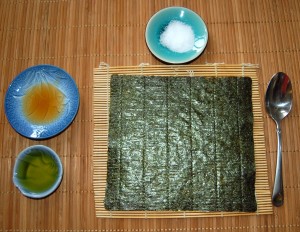
Spread the healthy oil on the seaweed. Each sheet will require about 1/2 to 1 teaspoon of oil (dried seaweed can really soak up oil). We favor using the back of a spoon to spread the oil.
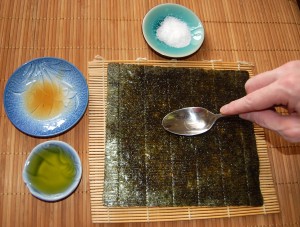
Sprinkle the salt (and any other seasonings) on the seaweed:

Place a new sheet on top of the previous one and repeat the application of oil and seasoning. It will pick up some oil and salt from the sheet underneath. In this photo, we’re applying coconut oil:
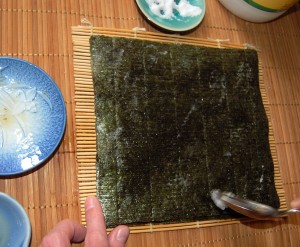
When you’ve finished your whole stack of sheets, place a few sheets on a baking sheet and bake at 350 degrees Fahrenheit (175 Celsius) for 2 minutes:
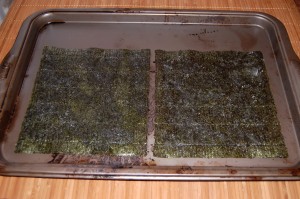
We baked each sheet individually, but it might be possible to bake a whole stack at once — we’ll try that next time.
The baked sheets may be easily folded and torn into more convenient sizes:
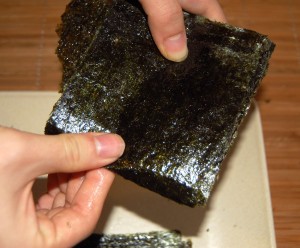
Here’s a finished stack:
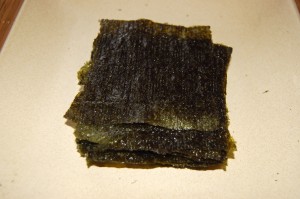
Voila! Just like grandma in Korea makes it. Eat the seaweed alone or with rice.











i love seaweed! i throw it in pretty much everything, never hurts!
Is there anything bad about eating massive amounts of these? I certainly have…
Hi Melissa – Not that I’m aware of!
What perfect timing! Just yesterday my husband asked me to buy some Korean seasoned seaweed but I refused, knowing full well they’d be made using rubbish oil. Now I can make my own. I’ll be using macadamia oil for my first try.
Happy to report this was a huge success. I used macadamia oil mixed with 2-3 drops of sesame oil – spread it on using a silicon pastry brush and then added a light sprinkling of salt. Very quick and easy.
What would you consider a reasonable single serve of these (assuming a serve is one quarter of a sheet). My husband does not have an off switch for these sorts of things. Are they very high in carbohydrate and what about iodine?
Also how to you stop them from sticking to the roof of your mouth 😉
Considering the high amount of iodine in some seaweed varieties, should people with certain thyroid conditions (like Hashimotos) be cautious about how much seaweed they consume, perhaps working up to higher amounts slowly, as you advise when supplementing iodine?
Hi GeeBee,
Macadamia oil! I’m jealous!
There’s negligible carbohydrate in seaweed, so this is a pure fatty treat. But adding a bit of rice may make it even more tasty.
I think a reasonable serving is when the local supermarket has run out of seaweed.
Hi Lillea,
Nori is relatively low in iodine, so I don’t think you have to worry. Kelp would be a concern, but kelp is not tasty.
But of course, people with Hashimoto’s should always listen to their bodies and be watchful for symptoms.
Looks delicious and the price is right considering its mineral content. My first thought was how many bowls of Total cereal deliver same degree of natural – as opposed to sprayer applied – minerals. Not to mention the extra costs in money and superfluous bulk & carbs.
Thank you for bringing yet another great product and its thoughtful preparation to light!
Here are some more seaweed ideas. Dulse can be eaten straight out of the bag. It is chewy and quite delicious. It can also be lightly toasted on stove-top or baked until crispy. It’s great in scrambled eggs or in stir-fries. I’m talking about the dulse strips — not the little tiny flakes or powdered variety. I use Maine Coast Sea Vegetables brand. Kelp can also be toasted or baked until crispy but it has large amounts of iodine so one should exercise portion control. Dulse is not as iodine rich as kelp. Eden Foods brand has an instant Japanese wakame that is pre-shredded (Wakame Flakes) — just add water and eat with oil and vinegar or toss in soups, salads, etc. Eden Foods also has a nori snack called Nori Krinkles which make a portable crunchy snack — no added oils or other ingredients.
Why is sesame oil OK? Doesn’t it have a lot of Omega-6?
Hi Rodney,
It does have a lot of omega-6, so it’s not OK in quantity, but it has a unique flavor and in small quantities as a flavoring agent we’ll use it.
Just wanted to add that I’ve been making up big batches of seasoned nori and have found a very efficient way of doing it. I bought a ‘Prepara Tabletop Oil Mister’ and filled it with macadamia oil. It gives a really even coverage of oil and is a great alternative to those aerosol spray can oils because you choose which oils to use and the oil reservoir is made from glass. You can see it here:
http://www.prepara.com/products/tabletop-mister/
I also made my own sesame seasoning by toasting sesame seeds and grinding them in a spice grinder. I spray on the oil, lightly sprinkle the ground sesame and do the same with some salt. I’ve also been using togarashi seasoning (Japanese 7 spice blend) for a spicier alternative.
Hi GeeBee, Great ideas!
Somebody should sell your version as a gourmet food. It sounds delicious. We’ll have to look for some macadamia oil and togarashi and try it out.
“Nori is relatively low in iodine, so I don’t think you have to worry. Kelp would be a concern, but kelp is not tasty.”
Dulse and wakame are also mentioned in these comments, and there are various other kinds of seaweed. Is there any way to get at least a semi-quantitative handle on the iodine content of the seaweed varieties of major interest?
“But of course, people with Hashimoto’s should always listen to their bodies and be watchful for symptoms.”
In the book, you also mention watching for symptoms while increasing iodine intake (for people in general, not just those with thyroid problems). What are the salient symptoms one should watch for?
Hi JBG,
Unfortunately iodine isn’t one of the minerals listed at nutritiondata.com, which uses USDA data.
I just use Google. Kelp is the highest, dulse is fairly high, wakame fairly low.
The symptoms are hyperthyroidism, hypothyroidism, and bromine toxicity. You can google all three for lists of symptoms. Usually the immediate effect is a mild hyperthyroidism. You may be agitated, have difficulty concentrating/working, and have disturbed sleep.
Thanks for info, Paul.
I am finding iodine a very confusing subject. At the simplest level, figures I’ve found on iodine concentration in nori are: 8, 12, 13, 16, 32, 33, and 100-300 ?g/g. The first six values I suppose could be attributed to natural variation in iodine content from one location to another, etc. I don’t know what to make of the last one.
Other problems: One site warns: “Nori also is one of the seaweeds with higher levels of bromine than iodine.”
Another says: “…sea vegetables have a high affinity for heavy metals, so unless certified organic, they may be grown in polluted waters from which they will absorb not only healthful minerals, but contaminants such as arsenic, lead, cadmium and/or mercury.”
I fully recognize that not everything found on the internet is to be taken seriously. The question is how to sort things out.
My work is continuing, and I will report further results here as I find them.
One question I will pose now. In the book, you indicate that successfully increased iodine intake results in decreased TSH readings, and the goal is to drive TSH to near zero. But every mention I’ve found of the effect of increased iodine on TSH is that it will *raise* it. Presumably there is a qualifier in there somewhere?
John
I notice the word processing machinery here doesn’t recognize mu for micro, so please read ?g/g above as mcg/g.
As I was putting my workfile away, I noticed I’d made an error. The iodine reading given above as 8 is actually 80. So the correct string is:
12, 13, 16, 32, 33, 80, and 100-300 mcg/g
(increasing its problematic character).
Sorry for the multiple posts.
Hi JBG,
Yes, I’ve had the same trouble figuring out seaweed iodine. Probably it’s highly variable, as are metal and halogen levels. That’s why I’ve shifted more toward elemental iodine even at low doses.
You might want to look at JVN’s experience on this thread: http://perfecthealthdiet.com/?page_id=1066#comment-18325 for an example of contaminants in seaweed having toxic effects.
Best, Paul
Paul, thanks for this cue. There is a LOT of good info there!
[i]You might want to look at JVN’s experience on this thread: http://perfecthealthdiet.com/?page_id=1066#comment-18325 for an example of contaminants in seaweed having toxic effects.[/i]
Because of my clumsy multiple posts, I think you overlooked this question:
[i]One question I will pose now. In the book, you indicate that successfully increased iodine intake results in decreased TSH readings, and the goal is to drive TSH to near zero. But every mention I’ve found of the effect of increased iodine on TSH is that it will *raise* it. Presumably there is a qualifier in there somewhere?[/i]
John
Hi John,
Iodine supplementation usually temporarily raises TSH while the body is adjusting to it, because TSH raises the level of iodine transporters and this is needed when blood levels are high but cellular levels low. But after a few weeks, you’ll adjust and TSH will go lower than it was.
So, months from now, when you’re fully adapted to a high dose, your TSH level should be low.
I am perfectly happy eating the nori straight up. Great snack right out of the package!
I was given a packet of seasoned seaweed from my precious Korean girlfriend. I cannot believe how BEAUTIFUL,WONDERFUL,DELICIOUS,YUMMIE,
this stuff is. I can be converted from potatoe chips to seasoned seaweed. I LOVED my chips for years!!! this is the BEST thing I have EVER tasted!!! I LOVE all the different ways you can season them with…I am going to try them too..
R.I.P. TO POTATOE CHIPS…Yaaaeeee…
Man, I sure wish I liked this. I tried it today and almost heaved. I had the nori taste in my mouth for a few hours afterward and just couldn’t kick it. It’s the reason sushi is hard for me to eat as well. I’d love to get seaweed in my diet, so I’m going to have to try to find some other way.
yummy seaweed snack~~
I’m eating it evaryday with my son.
also kimbap is one of my favorite food
a few questions…
i assume the oil is used to hold on the salt, couldn’t you use liquid amino spray? it has a slightly soy sauce flavor and could be yummy
i tend to like the hot and spicy flavor of seaweed snacks, any suggestions for a spice mix?
thanks! and thank you for the recipe 😀
Hi Paul,
Can I have seaweed with alcohol, or is it an omega 3 source?
Thanks,
Des
And now I can make wasabi-flavored seaweed snacks like the stores are carrying! With no canola oil! Yay.
They are utterly addictive. I can imagine these are even better—>WARM & fresh.
(I have wasabi powder that I will mix with the oil to flavor it)
Oh be still my heart…
i have some Japanese seaweed (flat squares) left over from tonight’s takeaway. Can I store them in some way? Seems such a waste to throw out .
I make these tasty snacks without oil, just water, wasabi powder and sea salt. Give them a try.
http://hungrynaturalist.blogspot.com/2016/02/vol-6-no-1-wasabi-roasted-nori-chips.html